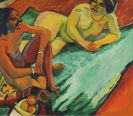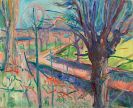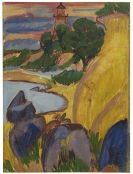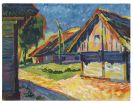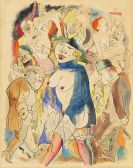
Hermann Obrist
Kilchberg
1862 -
München
1927
The Swiss sculptor and craftsman Hermann Obrist was one of the leading exponents of Jugendstil in Munich. Born in Kilchberg near Zurich in 1862, Hermann Obrist studied natural science and medicine in Heidelberg and Berlin from 1885 but decided to become an artist and transferred to the Kunstgewerbeschule (School for the Applied Arts) in Karlsruhe in 1888. By that time Hermann Obrist had already submitted early ceramic designs to the Ceramic Workshops in Bürgel, Thuringia. From 1889 Hermann Obrist lived for a while in Paris, where he worked as a sculptor. In Florence Hermann Obrist and Berthe Ruchet, also a Swiss, opened an art embroidery and tapestry workshop in 1892, which was moved to Munich in 1894.
In 1895 Hermann Obrist produced his most celebrated work, "Der Peitschenhieb" ["The Whiplash"], a large tapestry with embroidered vegetal motifs stylized into linear surface configurations. The whiplash motif recurs constantly in Hermann Obrist's work and was taken up by other artists, including August Endell. Hermann Obrist's floral embroideries were shown in "Pan" magazine. Obrist represented the entire plant, with finely ramified roots, foliage, intertwining stems, buds, flowers and stamens.
Starting from his knowledge of natural science and fascination with nature, Hermann Obrist arrived at decorative solutions typical of Jugendstil. In 1897 Hermann Obrist joined Bruno Paul, Bernhard Pankok, and Richard Riemerschmid in founding the "Vereinigte Werkstätten" for art in crafts in Munich (Kunst im Handwerk). That same year he showed his embroidered textiles at the "VIIth International Art Exhibition" in the Munich Glass Palace. Apart from wall hangings and ceramics, Hermann Obrist was so prolific and versatile that he also designed furniture and metalware, even several monuments and fountains.
Hermann Obrist designed a house for himself in Munich and had fellow artists design the interior. Richard Riemerschmid designed the furnishings and appoints of the bedrooms; Bernhard Pankok designed the dining room and the lobby. In 1902 Hermann Obrist and Wilhelm von Debschitz founded a school of design in Munich. Both as an artist and as a teacher, Hermann Obrist exerted an inspiring and seminal influence on the rise and development of Jugendstil in Germany.
Would you like to sell a work by Hermann Obrist?
Infos for seller
